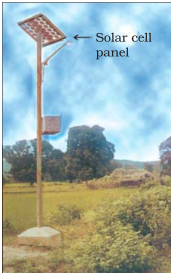PDF chapter test TRY NOW
It is clear that these devices are only useful at certain times of the day. Solar cells, which convert solar energy into electricity, overcome this limitation of using solar energy. When exposed to the Sun, a typical cell develops a voltage of 0.5–1 V and can produce about 0.7 W of electricity. A solar cell panel is made up of a large number of solar cells that can generate enough electricity for practical use.
Solar cells have a number of advantages, including the fact that they have no moving parts, require little maintenance, and work well without the use of a focusing device. Another advantage is that they can be installed in remote and inaccessible hamlets or sparsely populated areas where laying a power transmission line would be prohibitively expensive and unprofitable.

A solar cell panel
Although silicon, which is used to make solar cells, is plentiful in nature, the availability of special grade silicon for solar cell manufacturing is limited. The entire manufacturing process is still very expensive, and the use of silver for interconnecting the cells in the panel adds to the cost. Solar cells are used in a variety of scientific and technological applications despite their high cost and low efficiency. Solar cells are the primary source of energy for artificial satellites and space probes such as Mars orbiters. Solar cell panels are used in remote radio or wireless transmission systems, as well as TV relay stations. Solar cells are used in traffic signals, calculators, and a variety of toys. Solar cell panels are installed on specially designed inclined rooftops to allow more solar energy to pass through. However, solar cells are limited in their use in the home due to their high cost.
